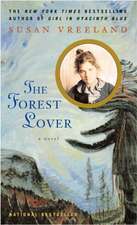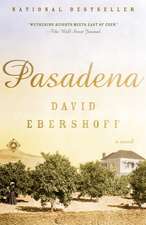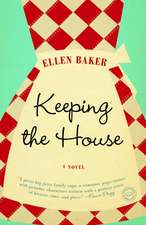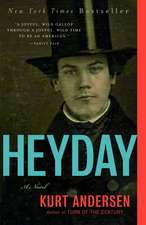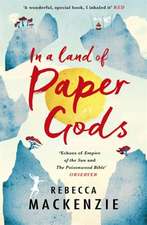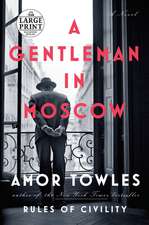Clara and Mr. Tiffany
Autor Susan Vreelanden Limba Engleză Paperback – 2 apr 2012
It’s 1893, and at the Chicago World’s Fair, Louis Comfort Tiffany makes his debut with a luminous exhibition of innovative stained-glass windows that he hopes will earn him a place on the international artistic stage. But behind the scenes in his New York studio is the freethinking Clara Driscoll, head of his women’s division, who conceives of and designs nearly all of the iconic leaded-glass lamps for which Tiffany will long be remembered. Never publicly acknowledged, Clara struggles with her desire for artistic recognition and the seemingly insurmountable challenges that she faces as a professional woman. She also yearns for love and companionship, and is devoted in different ways to five men, including Tiffany, who enforces a strict policy: He does not employ married women. Ultimately, Clara must decide what makes her happiest—the professional world of her hands or the personal world of her heart.
Look for special features inside.
Join the Circle for author chats and more.
RandomHouseReadersCircle.com
Preț: 95.29 lei
Nou
Puncte Express: 143
Preț estimativ în valută:
18.24€ • 18.97$ • 15.05£
18.24€ • 18.97$ • 15.05£
Carte disponibilă
Livrare economică 25 martie-08 aprilie
Livrare express 08-14 martie pentru 23.62 lei
Preluare comenzi: 021 569.72.76
Specificații
ISBN-13: 9780812980189
ISBN-10: 0812980182
Pagini: 423
Dimensiuni: 130 x 206 x 25 mm
Greutate: 0.33 kg
Editura: Random House Trade
ISBN-10: 0812980182
Pagini: 423
Dimensiuni: 130 x 206 x 25 mm
Greutate: 0.33 kg
Editura: Random House Trade
Notă biografică
Susan Vreeland is the New York Times bestselling author of five books, including Luncheon of the Boating Party, Life Studies, The Passion of Artemisia, The Forest Lover, and Girl in Hyacinth Blue. She lives in San Diego.
From the Hardcover edition.
From the Hardcover edition.
Extras
chapter 1
9781400068166|excerpt
Vreeland: CLARA AND MR. TIFFANY
Peacock
I opened the beveled-glass door under the sign announcing Tiffany Glass and Decorating Company in ornate bronze. A new sign with a new name. Fine. I felt new too.
In the ground-floor showroom of the five-story building, stained-glass windows hung from the high ceiling, and large mosaic panels leaned against the walls. Despite the urgency of my business, I couldn’t resist taking a quick look at the free-form vases, bronze desk sets, pendulum clocks, and Art Nouveau candelabras. It was the oil lamps that bothered me. Their blown-glass shades sat above squat, bulbous bases too earthbound to be elegant. Mr. Tiffany was capable of more grace than that.
A new young floor manager tried to stop me at the marble stairway. I gave him a look that implied, I was here before you were born, and pushed his arm away as though it were a Coney Island turnstile.
On the second floor, I peered into Mr. Tiffany’s large office-studio. With a gardenia pinned to his lapel, he sat at his desk behind a row of potted orchids. In February, no less! Such were the extravagances of wealth. His formerly trim bottle brush of a mustache had sprouted into robust ram’s horns.
His own paintings hung on the walls—Citadel Mosque of Old Cairo, with tall, slender minarets, and Market Day at Tangier, with a high tower on a distant hill. A new one depicted a lily on a tall stalk lording over a much shorter one. Amusing. Little Napoléon’s self-conscious preoccupation with height was alive and well.
New tall pedestals draped with bedouin shawls flanked the fireplace. On them Oriental vases held peacock feathers. In this his design sense went awry, sacrificed to his flamboyancy. If he wanted to appear taller, the pedestals should have been shorter. Someday I would tell him.
“Excuse me.”
“Why, Miss Wolcott!”
“Mrs. Driscoll. I got married, you remember.”
“Oh, yes. You can’t be wanting employment, then. My policy hasn’t—”
I pulled back my shoulders. “As of two weeks ago, I’m a single woman again.”
He was too much the gentleman to ask questions, but he couldn’t hide the gleam in his eyes.
“I’ve come to inquire if you have work for me. That is, if my performance pleased you before.” A deliberate prompt. I didn’t want to be hired because of my need or his kindness. I wanted my talent to be the reason he wanted me back.
“Indeed” was all he offered.
What now to fill the suspended moment? His new projects. I asked. His eyebrows leapt up in symmetrical curves.
“A Byzantine chapel for the World’s Columbian Exposition in Chicago next year. Four times bigger than the Paris Exposition Universelle. It will be the greatest assembly of artists since the fifteenth century.” He counted on his fingers and then drummed them on the desk. “Only fifteen months away. In 1893 the name of Louis Comfort Tiffany will be on the lips of millions!” He stood up and swung open his arms wide enough to embrace the whole world.
I sensed his open palm somewhere in the air behind the small of my back, ushering me to his massive, carved mahogany exhibit table to see his sketches and watercolors. “Two round windows, The Infancy of Christ and Botticelli’s Madonna and Child, will be set off by a dozen scenic side windows.”
A huge undertaking. How richly fortunate. Surely there would be opportunity for me to shine.
Practically hopping from side to side, he made a show of slinging down one large watercolor after another onto the Persian carpet, each one a precise, fine-edged rendering of what he wanted the window to be.
“Gracious! You’ve been on fire. Go slower! Give me a chance to admire each one.”
He unrolled the largest watercolor. “An eight-foot mosaic behind the altar depicting a pair of peacocks surrounded by grapevines.”
My breath whistled between my open lips. Above the peacocks facing each other, he had transformed the standard Christian icon of a crown of thorns into a shimmering regal headdress for God the King, the thorns replaced by large glass jewels in true Tiffany style.
Astonishing how he could get mere watercolors so deep and saturated, so like lacquer that they vibrated together as surely as chords of a great church pipe organ. Even the names of the hues bore an exotic richness. The peacocks’ necks in emerald green and sapphire blue. The tail feathers in vermilion, Spanish ocher, Florida gold. The jewels in the crown mandarin yellow and peridot. The background in turquoise and cobalt. Oh, to get my hands on those gorgeous hues. To feel the coolness of the blue glass, like solid pieces of the sea. To chip the gigantic jewels for the crown so they would sparkle and send out shafts of light. To forget everything but the glass before me and make of it something resplendent.
When I could trust my voice not to show too much eagerness, I said, “I see your originality is in good health. Only you would put peacocks in a chapel.”
“Don’t you know?” he said in a spoof of incredulity. “They symbolized eternal life in Byzantine art. Their flesh was thought to be incorruptible.”
“What a lucky find for you, that convenient tidbit of information.”
He chuckled, so I was on safe ground.
He tossed down more drawings. “A marble-and-mosaic altar surrounded by mosaic columns, and a baptismal font of opaque leaded glass and mosaic.”
“This dome is the lid of the basin? In opaque leaded glass?”
He looked at it with nothing short of love, and showed me its size with outstretched arms as though he were hugging the thing.
I was struck by a tantalizing idea. “Imagine it reduced in size and made of translucent glass instead. Once you figure how to secure the pieces in a dome, that could be the method and the shape of a lampshade. A wraparound window of, say”—I looked around the room—“peacock feathers.”
He jerked his head up with a startled expression, the idea dawning on him as if it were his own.
“Lampshades in leaded glass,” he said in wonder, his blue eyes sparking.
“Just think where that could go,” I whispered.
“I am. I am!” He tugged at his beard. “It’s brilliant! An entirely new product. We’ll be the first on the market. And not just peacock featherth. Flowerth too!”
Excitement overtook his struggle to control his lisp, which surfaced only when he spoke with passion.
“But the chapel first. This will be our secret for now.”
Men harboring secrets—I seemed attracted to them unwittingly.
“Besides the window department and the mosaic department, I have six women working on the chapel windows. I’ve always thought that women have greater sensitivity to nuances of color than men do. You’ve proved that yourself, so I want more women. You’ll be in charge of them.”
“That will suit me just fine.”
From the Hardcover edition.
9781400068166|excerpt
Vreeland: CLARA AND MR. TIFFANY
Peacock
I opened the beveled-glass door under the sign announcing Tiffany Glass and Decorating Company in ornate bronze. A new sign with a new name. Fine. I felt new too.
In the ground-floor showroom of the five-story building, stained-glass windows hung from the high ceiling, and large mosaic panels leaned against the walls. Despite the urgency of my business, I couldn’t resist taking a quick look at the free-form vases, bronze desk sets, pendulum clocks, and Art Nouveau candelabras. It was the oil lamps that bothered me. Their blown-glass shades sat above squat, bulbous bases too earthbound to be elegant. Mr. Tiffany was capable of more grace than that.
A new young floor manager tried to stop me at the marble stairway. I gave him a look that implied, I was here before you were born, and pushed his arm away as though it were a Coney Island turnstile.
On the second floor, I peered into Mr. Tiffany’s large office-studio. With a gardenia pinned to his lapel, he sat at his desk behind a row of potted orchids. In February, no less! Such were the extravagances of wealth. His formerly trim bottle brush of a mustache had sprouted into robust ram’s horns.
His own paintings hung on the walls—Citadel Mosque of Old Cairo, with tall, slender minarets, and Market Day at Tangier, with a high tower on a distant hill. A new one depicted a lily on a tall stalk lording over a much shorter one. Amusing. Little Napoléon’s self-conscious preoccupation with height was alive and well.
New tall pedestals draped with bedouin shawls flanked the fireplace. On them Oriental vases held peacock feathers. In this his design sense went awry, sacrificed to his flamboyancy. If he wanted to appear taller, the pedestals should have been shorter. Someday I would tell him.
“Excuse me.”
“Why, Miss Wolcott!”
“Mrs. Driscoll. I got married, you remember.”
“Oh, yes. You can’t be wanting employment, then. My policy hasn’t—”
I pulled back my shoulders. “As of two weeks ago, I’m a single woman again.”
He was too much the gentleman to ask questions, but he couldn’t hide the gleam in his eyes.
“I’ve come to inquire if you have work for me. That is, if my performance pleased you before.” A deliberate prompt. I didn’t want to be hired because of my need or his kindness. I wanted my talent to be the reason he wanted me back.
“Indeed” was all he offered.
What now to fill the suspended moment? His new projects. I asked. His eyebrows leapt up in symmetrical curves.
“A Byzantine chapel for the World’s Columbian Exposition in Chicago next year. Four times bigger than the Paris Exposition Universelle. It will be the greatest assembly of artists since the fifteenth century.” He counted on his fingers and then drummed them on the desk. “Only fifteen months away. In 1893 the name of Louis Comfort Tiffany will be on the lips of millions!” He stood up and swung open his arms wide enough to embrace the whole world.
I sensed his open palm somewhere in the air behind the small of my back, ushering me to his massive, carved mahogany exhibit table to see his sketches and watercolors. “Two round windows, The Infancy of Christ and Botticelli’s Madonna and Child, will be set off by a dozen scenic side windows.”
A huge undertaking. How richly fortunate. Surely there would be opportunity for me to shine.
Practically hopping from side to side, he made a show of slinging down one large watercolor after another onto the Persian carpet, each one a precise, fine-edged rendering of what he wanted the window to be.
“Gracious! You’ve been on fire. Go slower! Give me a chance to admire each one.”
He unrolled the largest watercolor. “An eight-foot mosaic behind the altar depicting a pair of peacocks surrounded by grapevines.”
My breath whistled between my open lips. Above the peacocks facing each other, he had transformed the standard Christian icon of a crown of thorns into a shimmering regal headdress for God the King, the thorns replaced by large glass jewels in true Tiffany style.
Astonishing how he could get mere watercolors so deep and saturated, so like lacquer that they vibrated together as surely as chords of a great church pipe organ. Even the names of the hues bore an exotic richness. The peacocks’ necks in emerald green and sapphire blue. The tail feathers in vermilion, Spanish ocher, Florida gold. The jewels in the crown mandarin yellow and peridot. The background in turquoise and cobalt. Oh, to get my hands on those gorgeous hues. To feel the coolness of the blue glass, like solid pieces of the sea. To chip the gigantic jewels for the crown so they would sparkle and send out shafts of light. To forget everything but the glass before me and make of it something resplendent.
When I could trust my voice not to show too much eagerness, I said, “I see your originality is in good health. Only you would put peacocks in a chapel.”
“Don’t you know?” he said in a spoof of incredulity. “They symbolized eternal life in Byzantine art. Their flesh was thought to be incorruptible.”
“What a lucky find for you, that convenient tidbit of information.”
He chuckled, so I was on safe ground.
He tossed down more drawings. “A marble-and-mosaic altar surrounded by mosaic columns, and a baptismal font of opaque leaded glass and mosaic.”
“This dome is the lid of the basin? In opaque leaded glass?”
He looked at it with nothing short of love, and showed me its size with outstretched arms as though he were hugging the thing.
I was struck by a tantalizing idea. “Imagine it reduced in size and made of translucent glass instead. Once you figure how to secure the pieces in a dome, that could be the method and the shape of a lampshade. A wraparound window of, say”—I looked around the room—“peacock feathers.”
He jerked his head up with a startled expression, the idea dawning on him as if it were his own.
“Lampshades in leaded glass,” he said in wonder, his blue eyes sparking.
“Just think where that could go,” I whispered.
“I am. I am!” He tugged at his beard. “It’s brilliant! An entirely new product. We’ll be the first on the market. And not just peacock featherth. Flowerth too!”
Excitement overtook his struggle to control his lisp, which surfaced only when he spoke with passion.
“But the chapel first. This will be our secret for now.”
Men harboring secrets—I seemed attracted to them unwittingly.
“Besides the window department and the mosaic department, I have six women working on the chapel windows. I’ve always thought that women have greater sensitivity to nuances of color than men do. You’ve proved that yourself, so I want more women. You’ll be in charge of them.”
“That will suit me just fine.”
From the Hardcover edition.
Recenzii
“Vreeland’s ability to make this complex historical novel as luminous as a Tiffany lamp is nothing less than remarkable.”—The Washington Post
“A novel as sparkling and elegant as a Tiffany lampshade . . . a sensitive portrayal of women’s struggles in the nineteenth century . . . [Susan Vreeland] has captured the tone of an era. . . . The consistent elegance and vitality of her prose make reading her book a pleasure.”—Minneapolis Star Tribune
“As she did for a Vermeer painting in Girl in Hyacinth Blue, Vreeland traces the secret history of an objet d’art—this time, the iconic Tiffany lamp. . . . A fascinating look at at turn-of-the-century New York City.”—People (4 out of 4 stars)
“Vreeland’s writing is so graceful, her research so exhaustive, that a reader can’t help becoming enfolded in this fascinating world.”—Los Angeles Times
“There’s no excuse for any reader of high-quality literary fiction to let this novel pass by.”—Booklist (starred review)
“A novel as sparkling and elegant as a Tiffany lampshade . . . a sensitive portrayal of women’s struggles in the nineteenth century . . . [Susan Vreeland] has captured the tone of an era. . . . The consistent elegance and vitality of her prose make reading her book a pleasure.”—Minneapolis Star Tribune
“As she did for a Vermeer painting in Girl in Hyacinth Blue, Vreeland traces the secret history of an objet d’art—this time, the iconic Tiffany lamp. . . . A fascinating look at at turn-of-the-century New York City.”—People (4 out of 4 stars)
“Vreeland’s writing is so graceful, her research so exhaustive, that a reader can’t help becoming enfolded in this fascinating world.”—Los Angeles Times
“There’s no excuse for any reader of high-quality literary fiction to let this novel pass by.”—Booklist (starred review)
Descriere
The "New York Times"-bestselling author of "The Girl in Hyacinth Blue" creates a dynamic portrait of Clara Driscoll: lead designer for Louis Comfort Tiffany (famous for Tiffany lamps) and a woman conflicted between her desires for artistic recognition and romantic love.


